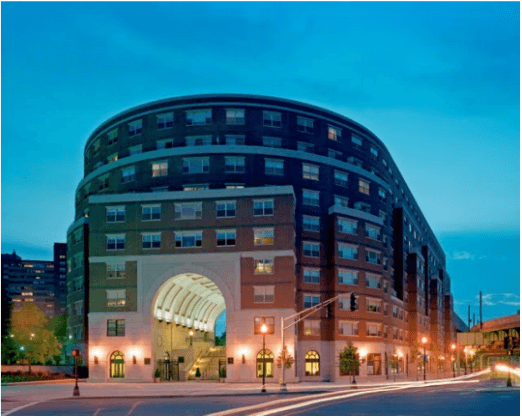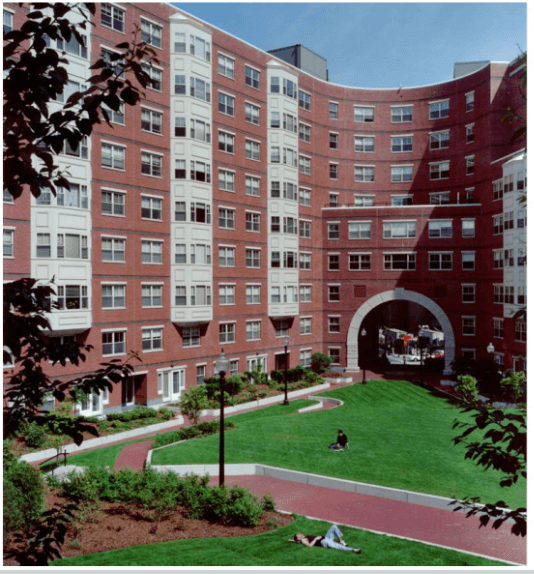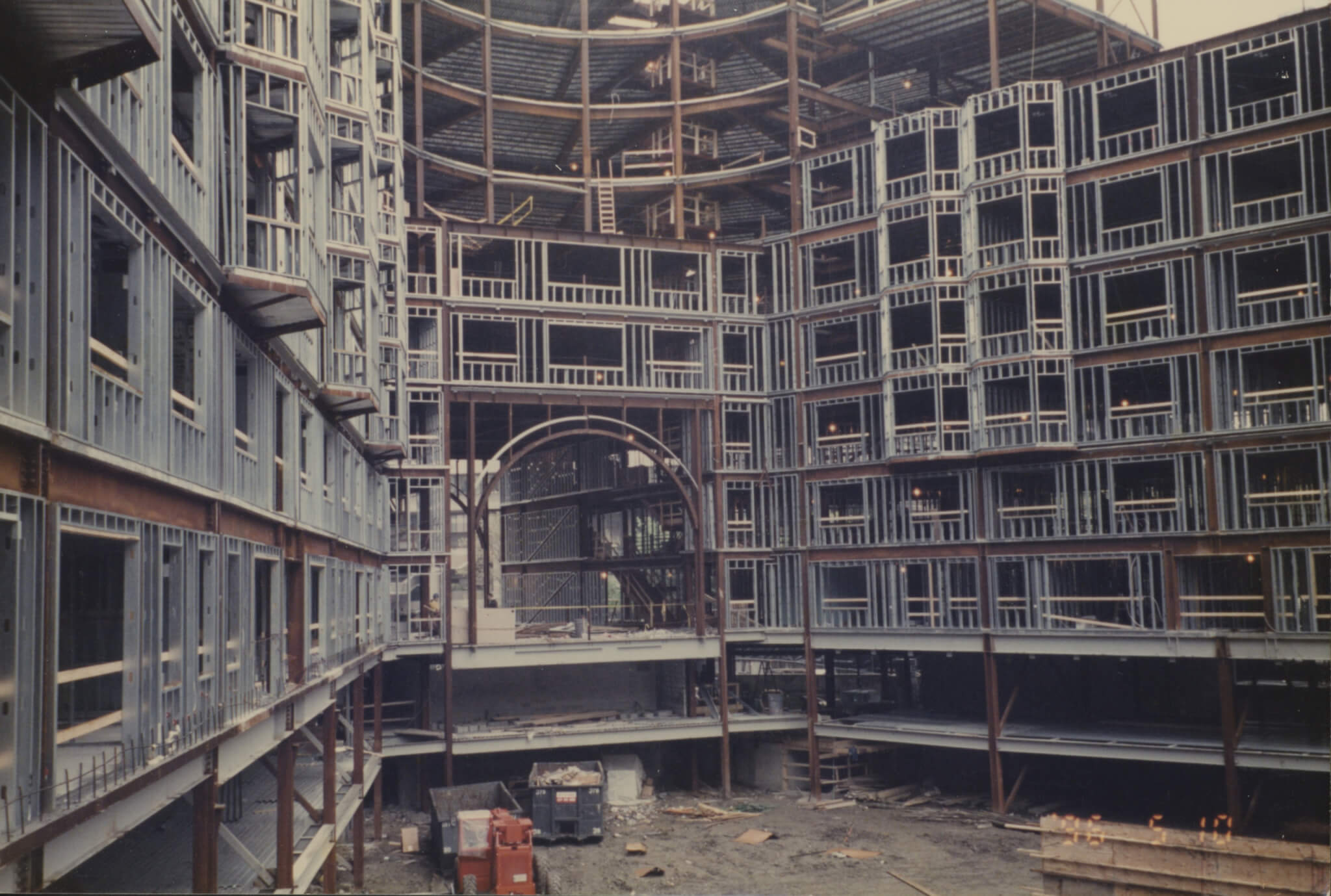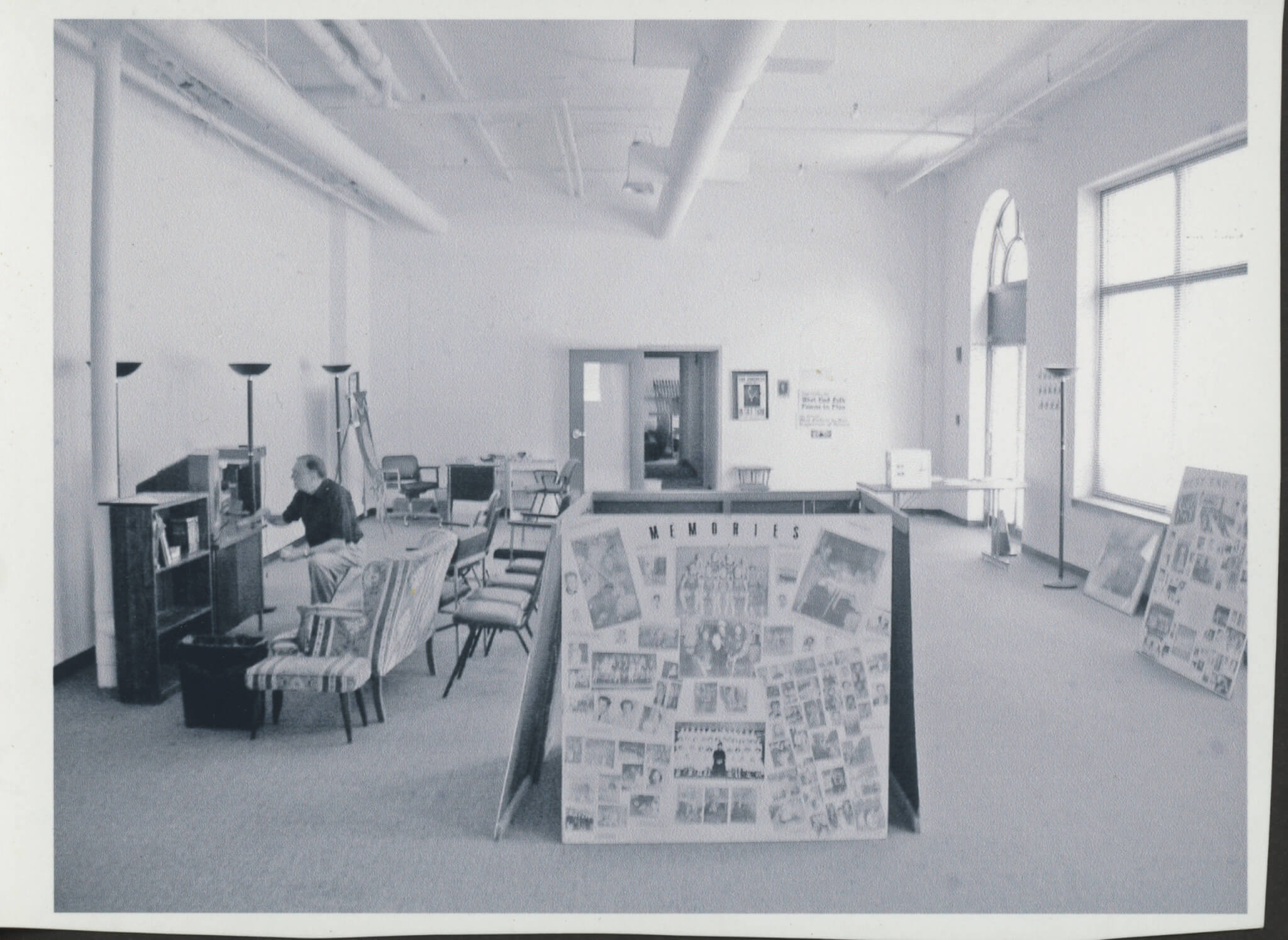West End Place
West End Place, the mixed-income condominium complex on Staniford Street, is the home of The West End Museum. West End Place, like the Museum, owes its existence to the dedicated activism of displaced former residents who hoped to right the wrongs of urban renewal.
West End Place, which opened on the corner of Causeway, Merrimac, and Staniford Streets in 1997, is a mixed-income apartment complex at the heart of the historic West End. Known for its large archway, rounded exterior, commercial spaces, and interior courtyard, West End Place has also been home to The West End Museum since 2004. Split between two housing cooperatives, West End Place offers units at market rate in addition to affordable apartments subsidized by Boston’s Department of Neighborhood Development and the United States Department of Housing and Urban Development (HUD). Residents of West End Place have spoken fondly of their building as a diverse community of classes and cultures, brought together through its Neighborhood Relations Committee. West End Place has received awards for its architectural design from the New England Chapter of the American Institute of Architects and the National Masonry Institute. But most importantly, West End Place became the home of The West End Museum (WEM) because of the persistent activism of West Enders – particularly WEM founder Jim Campano.
Former West Enders, such as Joseph LoPiccolo, provided the impetus for West End Place when they advocated for the Boston Redevelopment Authority (BRA) to take control of the last undeveloped parcel of the original urban renewal zone from Jerome Rappaport, the developer of Charles River Park. In 1992, Jim Campano, the former resident who founded The West Ender Newsletter, and others established the Old West End Housing Corporation (OWEHC), which negotiated the development of West End Place. After the BRA seized back the property, it selected the Planning Office for Urban Affairs of the Archdiocese of Boston and the Keen Development Corporation to build a mixed-income residential community. West End Place was intended in part to help right the wrongs of urban renewal. Originally, Boston city planners promised affordable housing as part of the project, but in the end the development included only luxury condos and a vast majority of West Enders were displaced.
West End Place involved many players from the public and private sectors, and it was constructed at the time when Boston’s downtown was being significantly transformed by the Big Dig. The financing for West End Place came from the Massachusetts Department of Housing and Community Development, the BRA, Bank of Boston, AFL-CIO Housing Trust, and the Federal National Mortgage Association. The architect of West End Place was Michael Liu, from The Architectural Team in Chelsea, MA. Liu chose a curved design for West End Place to represent the merging of multiple streets and neighborhoods. When West End Place opened in 1997, the elevated Green Line track that ran above Causeway Street posed a logistical problem: one of its steel columns blocked the exit of the West End Place garage. The elevated track was finally torn down in 2004 during the removal of the Central Artery as part of the Big Dig. Robert Kuehn, president of Keen Development Corp. and also a resident of West End Place, remarked that the removal of the track was “a double treat for me; pride as a builder and the views I now have as a resident.”
From the beginning, West End Place had to contend with the objections of original West Enders, who advocated that former residents displaced by urban renewal be prioritized in the allocation of affordable housing. To comply with federal laws prohibiting racial discrimination in housing, West End Place had to prioritize underrepresented minorities through affirmative marketing of affordable housing units to other communities such as Roxbury and Chinatown. Though West End Place had allocated a certain percentage of subsidized and market-rate units to former West Enders, OWEHC felt that the planned 34% allocation of low-income units to displaced former residents was not enough.
In 1996, OWEHC filed a federal lawsuit arguing that federal fair housing laws should be superseded by a City Council agreement from 1950, which established that West Enders had the “right of first refusal” of any housing built in the neighborhood. The Boston City Council, also in 1996, voted 9-3 to allocate $25,000 for West Enders to hire an attorney for their legal claim to preferential housing at West End Place. Boston Mayor Thomas Menino vetoed this allocation of funding on the basis that it was an illegal use of city funds, but he had previously persuaded HUD officials to allow for 43 of the 106 low-income and moderate-income units of West End Place to be allocated to former West Enders. The U.S. District Court and 1st Circuit Court of Appeals each dismissed OWEHC’s suit, ruling that because West End Place received federal funding, federal fair housing laws took constitutional precedence.
As a concession to former West Enders, West End Place provided them with a storefront unit on the ground floor of the complex for the establishment of a West End museum or visitor center, an archive, and offices for OWEHC and the The West Ender Newsletter. West End Place charged OWEHC a modest condo maintenance fee of $1,100 a month, but provided no additional funding for the Museum’s upkeep. After its opening in 2004, The West End Museum struggled to survive financially, but it persisted long enough to hold a second grand opening in 2007 after receiving and installing “The Last Tenement” exhibit, a gift from its original creator, The Bostonian Society. Today, West End Place is home to a mix of old and new West Enders, living together in a noteworthy building at the center of an ever-changing neighborhood.
Article by Adam Tomasi, edited by Bob Potenza
Sources: Sources: West End Place; Boston’s Luxury Properties; West End Museum; ProQuest/Boston Globe (Tara Murphy, “As convention closes in, the closest brace for impact,” July 18, 2004; Kathleen Howley, “Four-Story Arch Leads to Condos in the West End,” January 25, 1998; Alan Lupo, “Trends, formulas split tenants over West End housing,” April 28,1996; Monica Collins, “A detour for permit parking idea: Where home, but not garage, is affordable,” November 20, 2005; Judy Rakowsky, “Former West Enders Head to Supreme Court,” April 29, 1998; Collins, “Born again: Flattened 50 years ago in the name of urban renewal, the West End is once again in turmoil over its future,” August 7, 2005; Collins, “A Valentine for the Vanquished, as Museum Gathers the Gang,” February 6, 2005)












